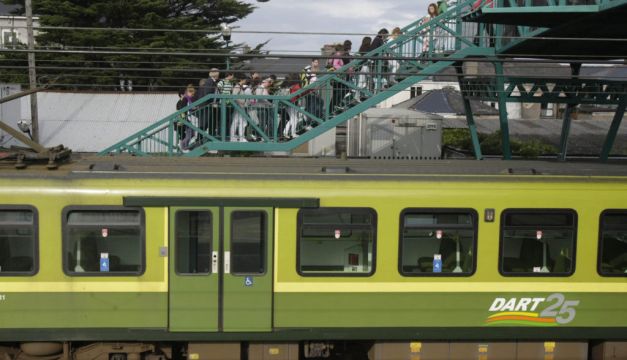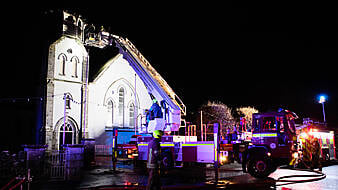A collision between two Dart services travelling to Bray was narrowly avoided near Clontarf during Storm Barra in 2021 after a driver passed through two red light signals on the line.
A report by the Railway Accident Investigation Unit has revealed how a train came within 5 seconds of crashing into the rear of another Dart service on the southbound track between Clontarf Road station and an Iarnród Éireann depot at Fairview at around 4pm on December 7th, 2021.
The collision was avoided after the driver who passed through a second red light – known as a “signal passed at danger” (SPAD) – alerted a controller that he believed his train was sliding and was going to run into the back of the other Dart ahead on the line.
The controller requested the driver of the other train, which had stopped at the Fairview depot ramp to switch drivers, to keep moving.
The second Dart managed to come to a stop just before the ramp and five metres from the point of potential collision.
The RAIU report said the second Dart service “would likely have collided with the rear [of the first train]” but for the evasive action, estimating the collision was avoided by five seconds.
“Under slightly different circumstances, the failure may have led to a serious accident with the potential for fatality or serious injuries due to one passenger train almost colliding with another,” it added.
The report revealedthe train which was responsible for the two SPADs was travelling at 79km/hr as it came into a section on approach to Clontarf Road station, which had a speed limit of 30km/hr.
An official investigation concluded that the driver of the second Dart was over reliant on the train’s Automatic Train Protection system which initiates automatic braking if it exceeds a target speed.
Weather conditions
The report noted there was also “low rail adhesion” (colloquially known as “leaves on the line”) on the date of the incident as a result of Storm Barra, which would have impacted on the train’s braking ability and stopping distances.
It also observed that a majority of trains were running late on the day because of the storm.
Another Dart driver told investigators that rail conditions at the time were “very poor”, while drivers had been alerted about a moderate risk of low rail adhesion two hours before the incident.
The report concluded other factors included the sharp reduction in speed limits from 75km/hr to 30km/hr on the approach to the signal on the northside of Clontarf Road station, and the failure of the driver of the second train to apply correct driving techniques.
An automatic system on the train for sanding the rail also stopped working during the braking incident.
The RAIU noted that a previous assessment of the driver of the second train had not identified his over-reliance on the automatic braking system.
In addition, investigators pointed out that two recommendations made as a result of a previous SPAD incident in 2016 regarding the over-reliance of drivers on the automatic braking system could have potentially avoided the incident near Clontarf if they had been fully implemented.
They claimed that Iarnród Éireann had not fully appreciated the risk of drivers being over-reliant on the Automatic Train Protection system and had shown no urgency in implementing previous recommendations about the similar incident seven years ago.
Guidelines
The RAIU made a total of 12 safety recommendations including for Iarnród Éireann’s head of health and safety to arrange for the development of guidelines for drivers on the understanding of the automatic braking system and the required driving techniques.
It also called on Iarnród Éireann to review the spacing between signals and particularly any sharp speed decreases on approaches to signals on the rail network.
The RAIU said train drivers should also be briefed on the importance of making an open call to all other drivers in an emergency situation rather than calling a controller.
Following the incident, Iarnród Éireann said it had issued a safety alert to all drivers later that day that low rail adhesion can reduce a train’s braking ability by up to 75 per cent.
It subsequently put in place a development and support plan for the driver of the second Dart, as well as reviewing how it assesses the driving techniques of all drivers.
Iarnród Éireann said it also briefed all Dart drivers about the incident, in addition to processes for making emergency calls and on the location of sharp speed limit reductions.
Following a separate review of the incident, the railway safety watchdog – the Commission for Railway Regulation – said it had identified five minor non-compliances with railway safety.
It also made a number of recommendations to Iarnród Éireann for improving passenger safety







